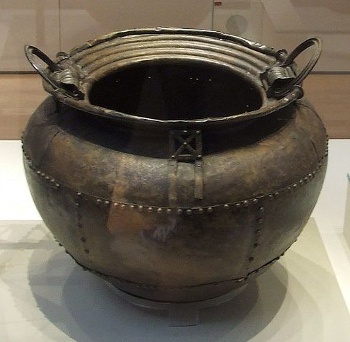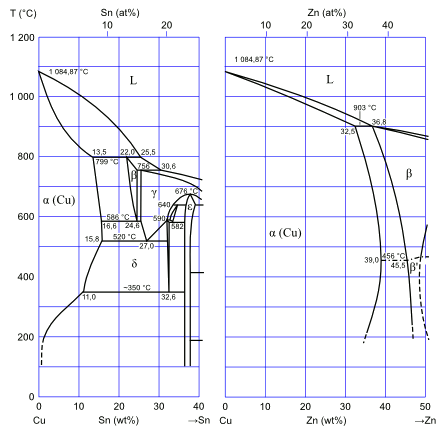Antimicrobial Alloys
January 31, 2014
Hesiod, a
Greek poet of the
seventh or
eighth century BC, is known for two major works. One of these is the
Theogony, a
poem that describing the origins and
genealogies of the
Greek gods. The other is the "
Works and Days" a short, 800 line poem, written by Hesiod to his brother as an exhortation of how he should live his life. The Works and Days also contains tips on
agriculture, but it's better known for Hesiod's listing of the
Five Ages of Man, a progression that seemed to indicate the
decline of civilization.
• The Golden Age, a supposed time of peace, harmony, and easy living.
• The Silver Age, not as pleasant as the Golden Age, but humans had a lifespan of a hundred years.
• The Bronze Age, in which humans waged war with bronze swords, eventually exterminating themselves.
• The Heroic Age, the age of heroes and the Trojan War.
• The Iron Age, Hesiod's age, a world of many ills, as seen in the excerpt, below.

"For now truly is a race of iron, and men never rest from labor and sorrow by day, and from perishing by night; and the gods shall lay sore trouble upon them." [Hesiod, Works and Days, ll. 176-178]. (Via Project Perseus))
While it's true that
gold and
silver were the first
metals used by humans, principally because they can be found as free metal in
mineral deposits,
archaeologists don't have a Gold Age or a Silver Age in their
chronology. Instead, they use a
three-age system of a
Stone Age, followed by a Bronze Age, and then the Iron Age
Bronze is an alloy of
copper and
tin in which the tin is
dissolved in copper to
harden it without changing its
crystal structure. Bronze exists over a range of tin concentrations, but modern bronze generally contains about 10% tin.
To make bronze, you need both copper and tin, so these existed before the Bronze Age. There's evidence of
copper smelting as far back as 5000
BC, and there's a short
Copper Age that precedes the Bronze Age. Pure copper is too soft for wide application, so the creation of bronze was a significant point in human history.

Bronze Age bronze cauldron in the British Museum.
(Photograph by J. Miall, via Wikimedia Commons.)
As confirmed by the names of these ages, we've been defined by our materials throughout all history, and sometimes these materials have side effects in their use. It's conjectured that one factor in the
fall of the Roman Empire was the use of
lead containers in the production of
wine and the use of lead wine goblets by the
ruling class.[1] However, the use of metal implements in food and drink preparation is often beneficial.
The most common example of this is the beating of
egg whites (
chicken egg albumen) in a copper bowl to produce a light
foam for making a
meringue. The trick with meringues is that they are destroyed by overheating, and two centuries ago it was discovered that this was less of a problem when copper is used in the process. A paper in
Nature in 1984 discovered that the mechanism for this was the incorporation of copper into the
protein to form
conalbumin, which
denatures at a ten degree
Fahrenheit higher
temperature.[2]
Interestingly, copper is listed as a
toxic chemical by the
US Environmental Protection Agency (EPA), as are many other metals. Since we not only beat egg whites in copper bowls, but also carry
copper coins in our pockets, there more to toxicity than just an
atomic number. Elemental copper, however, is
toxic to bacteria, which is a useful property in this age of
antibiotic resistance.
The EPA has decided that
alloys containing at least 65% copper are inherently
antimicrobial. This property was known, but not understood, in
antiquity, since it was observed that
water held in copper showed diminished
slime formation. More recently,
copper salts have been used to control
algae,
molds,
fungi and
microbes. Articles made from copper and its alloys, such as bronze and brass, kill most microbes within a few hours.
Surprisingly,
stainless steel, which is the metal of choice in
hospitals,
doctor's offices and industrial
kitchens, is not anti-microbial. The toxic
O157:H7 strain of E. coli bacteria can remain viable on the surface of stainless steel for weeks. In comparison, such bacteria are killed on 99.95% pure copper in just ninety minutes at
room temperature. Brass and bronze, both of which contain high copper concentrations (see figure), have a similar property, killing microbes within a few hours. Such data make brass or bronze
doorknobs a worthwhile investment, as long as they aren't coated.

The bronze and brass portions (α-Cu) of the copper-tin and copper-zinc phase diagrams.
(Cu-Sn and Cu-Zn phase diagrams, via Wikimedia Commons, modified.)
Copper is apparently effective also against
Methicillin-resistant Staphylococcus aureus (MRSA) and the
influenza A virus. A patent application has been filed on a range of copper alloys shown to be effective antimicrobrials and also
tarnish-resistant.[3] These copper alloys contain between 1-4%
nickel, 0-3%
aluminum, and optionally zinc and
manganese up to 15%.[3]
Another alloy composition,
MD-Cu29, contains 63.1-69.8% copper, 1.0-33.0% nickel, 0-24.4% zinc, 0-2.30%
iron, and 0-2.50% manganese.[4] Two hour's contact with this alloy has been shown to kill greater than 99.9% of
Vancomycin-resistant Enterococcus (VRE),
Staphylococcus aureus,
Enterobacter aerogenes, E. coli O157:H7,
Pseudomonas aeruginosa and MRSA.[5]
Hussey Copper is using this alloy in the manufacture of
bathroom sinks,
switch and
door plates,
cabinet hardware and
tiling.[6]
References:
- Lead Poisoning and Rome, University of Chicago Web Site.
- Harold J. McGee, Sharon R. Long and Winslow R. Briggs, "Why whip egg whites in copper bowls?" Nature, vol. 308, no. 5960 (April 12, 1984), pp. 667-668.
- Carole Lynne Trybus, Richard P. Vierod and Peter William Robinson, "Antitarnish, antimicrobial copper alloys and surfaces made from such alloys," US Patent Application No. 20110165013 A1, July 7, 2011.
- Materials Safety Data Sheet (MSDS) for MD-Cu29 Alloy, via Kelley Solutions.
- MD-Cu29 Alloy Web Site.
- Len Boselovic, "Hussey Copper launches line of anti-bacterial fixtures," Pittsburgh Post-Gazette, January 13, 2014.
Permanent Link to this article
Linked Keywords: Hesiod; Greek; poet; 7th century BC; 8th century BC; Theogony; poetry; poem; genealogy; genealogies; Greek mythology; Greek gods; Works and Days; agriculture; Five Ages of Man; societal collapse; decline of civilization; Golden Age; Silver Age; longevity; lifespan; Bronze Age; bronze; sword; Greek Heroic Age; Greek heroes; Trojan War; Iron Age; Project Perseus; gold; silver; metal; lode; mineral deposit; archaeology; archaeologist; chronology; three-age system; Stone Age; bronze; copper; tin; solid solution; solid solution strengthening; crystal structure; copper smelting; Anno Domini; BC; Chalcolithic; Copper Age; cauldron; British Museum; Wikimedia Commons; Fall of the Western Roman Empire; lead; wine; ruling class; egg white; chicken egg; albumen; foam; meringue; Nature; protein; conalbumin; denaturation; denature; Fahrenheit; temperature; toxicity; toxic chemical; United States Environmental Protection Agency; penny; copper coin; atomic number; chemical element; antimicrobial properties of copper; antibiotic resistance; alloy; antimicrobial; classical antiquity; water; biofilm; slime; copper compound; copper salt; algae; mold; fungus; fungi; microorganism; microbe; stainless steel; hospital; physician; kitchen; Escherichia coli O157:H7; strain; room temperature; door handle; doorknob; phase diagram; Cu-Sn; Cu-Zn; Methicillin-resistant Staphylococcus aureus; MRSA; influenza A virus; tarnish; nickel; aluminum; manganese; MD-Cu29; iron; Vancomycin-resistant Enterococcus; Staphylococcus aureus; Enterobacter aerogenes; Pseudomonas aeruginosa; Hussey Copper; bathroom; sink; light switch; door; cabinet; hardware; tile; tiling.